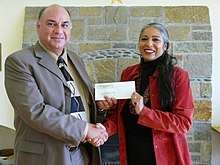
Back وامبانواغ Arabic Vampanoaqlar Azerbaijani Вампаноаг Byelorussian Уампаноаги Bulgarian Wampanoag Catalan Wampanoag Danish Wampanoag German Wampanoag Spanish Wampanoag herria Basque Wampanoagit Finnish
Wôpanâak | |
|---|---|
 Cheryl Andrews-Maltais (right), Chairperson of the Wampanoag Tribe of Aquinnah with a MassDOT engineer | |
| Total population | |
| 2,756 (2010 census),[1][2] 3,841 (2023) | |
| Regions with significant populations | |
| Massachusetts, formerly Rhode Island[3] | |
| Languages | |
| English, historically Wôpanâak[4] | |
| Religion | |
| Indigenous religion, Christianity | |
| Related ethnic groups | |
| Massachusett, Agawam, Nauset Naumkeag, and other Algonquian peoples |

The Wampanoag (/ˈwɑːmpənɔːɡ/), also rendered Wôpanâak, are a Native American people of the Northeastern Woodlands currently based in southeastern Massachusetts and formerly parts of eastern Rhode Island.[3] Their historical territory includes the islands of Martha's Vineyard and Nantucket.
Today, two Wampanoag tribes are federally recognized:
The Wampanoag language, also known as Massachusett, is a Southern New England Algonquian language.[4]
Prior to English contact in the 17th century, the Wampanoag numbered as many as 40,000 people living across 67 villages composing the Wampanoag Nation.[6] These villages covered the territory along the east coast as far as Wessagusset (today called Weymouth), all of what is now Cape Cod and the islands of Natocket and Noepe (now called Nantucket and Martha's Vineyard), and southeast as far as Pokanocket (now Bristol and Warren, Rhode Island).[7] The Wampanoag lived on this land for over 12,000 years.[8]
From 1615 to 1619, a leptospirosis epidemic caused by rodent reservoirs from European ships dramatically reduced the population of the Wampanoag and neighboring tribes. Indigenous deaths from the epidemic facilitated the European invasion and colonization of the Massachusetts Bay Colony.[9] More than 50 years later, Wampanoag Chief Sachem Metacom and his allies waged King Philip's War (1675–1676) against the colonists. The war resulted in the death of 40 percent of the surviving Wampanoag. The English sold many Wampanoag men into slavery in Bermuda, the West Indies, or on plantations and farms run by colonists in New England.
Today, Wampanoag people continue to live in historical homelands and maintain central aspects of their culture while adapting to changing socioeconomic needs. Oral traditions, ceremonies, song and dance, social gatherings, and hunting and fishing remain important traditional ways of life to the Wampanoag.[10] In 2015, the federal government declared 150 acres of land in Mashpee and 170 acres of land in Taunton as the Mashpee Wampanoag Tribe’s initial reservation, on which the Tribe can exercise its full tribal sovereignty rights.[11] The Mashpee tribe currently has approximately 3,200 enrolled citizens.[12] The Wampanoag Tribe of Gay Head currently has 901 enrolled citizens.[13] Early 21st-century population estimates indicated a total of 4,500 Wampanoag descendants.[14]
Wampanoag activists have been reviving the Wampanoag language; Mashpee High School began a course in 2018 teaching the language.[15][16]
- ^ "Massachusetts: 2010; Population and Housing Unit Counts" (PDF). US Census 2010. US Department of Commerce. August 2012. Retrieved August 28, 2022.
- ^ "2010 Census CPH-T-6. American Indian and Alaska Native Tribes in the United States and Puerto Rico: 2010" (PDF). Retrieved November 19, 2023.
- ^ a b Salwen, "Indians of Southern New England and Long Island," p. 171.
- ^ a b Cite error: The named reference
omniglotwas invoked but never defined (see the help page). - ^ Herring Pond Tribe is a historical Wampanoag Tribe located in Plymouth and Bourne, Massachusetts Bureau of Indian Affairs (January 28, 2022). "Indian Entities Recognized by and Eligible To Receive Services From the United States Bureau of Indian Affairs". Federal Register. 86 (FR 7554): 4636. Retrieved August 28, 2022.
- ^ "Who are the Wampanoag?". Plimoth Patuxet Museums. Retrieved November 21, 2023.
- ^ "Who are the Wampanoag?". Plimoth Patuxet Museums. Retrieved November 21, 2023.
- ^ "Mashpee Wampanoag Tribe". Mashpee Wampanoag Tribe. November 20, 2023. Retrieved November 21, 2023.
- ^ Marr JS, Cathey JT. "New hypothesis for cause of an epidemic among Native Americans, New England, 1616–1619", Emerging Infectious Diseases, Centers for Disease Control, 2010 Feb doi:10.3201/edi1602.090276
- ^ "Who are the Wampanoag?". Plimoth Patuxet Museums. Retrieved November 21, 2023.
- ^ "Mashpee Wampanoag Tribe". Mashpee Wampanoag Tribe. November 20, 2023. Retrieved November 21, 2023.
- ^ "Mashpee Wampanoag Tribe". Mashpee Wampanoag Tribe. November 20, 2023. Retrieved November 21, 2023.
- ^ "Wampanoag History". Wampanoag Tribe of Gay Head (Aquinnah). Retrieved November 21, 2023.
- ^ "Wampanoag | Definition, History, Government, Food, & Facts | Britannica". www.britannica.com. Retrieved November 21, 2023.
- ^ Cite error: The named reference
:1was invoked but never defined (see the help page). - ^ Cite error: The named reference
Mifflinwas invoked but never defined (see the help page).